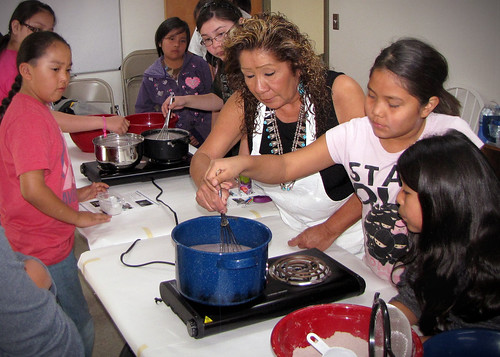
Bertha Etsitty helps 4-H members make traditional blue corn mush during a club activity. Photo by Leah Platero
Nutritional security is defined as “a situation that exists when all people, at all times, have physical, social, and economic access to sufficient, safe, and nutritious food that meets their dietary needs and food preferences for an active and healthy life.”
Achieving nutritional security in the context of the burgeoning population, climate change, diminishing land and water resources, environmental degradation, and changing incomes and diets will require not just approaches to sustainably producing more food, but also smarter ways of producing food, dealing with food waste, and promoting improved nutritional outcomes. The National Institute of Food and Agriculture (NIFA) invests in and advances agricultural research, education, and extension and seeks to make transformative discoveries that solve these societal challenges. NIFA’s portfolio of support for nutritional security and sustainable agriculture includes literally thousands of impactful efforts across our nation; below are just a handful that speak to the transformative work transforming lives. For example:
Healthy lifestyles are critical to address obesity and diabetes, which are rampant in Native American communities. To this end, Southwest Indian Polytechnic Institute in New Mexico has created the successful Seven Generations of Native Health programs, which include topics such as understanding food labels, food consumption, and cholesterol.
Almost 80 percent of the consumptive use of freshwater is in the food we consume, and agricultural irrigation accounts for 62 percent of freshwater use in the United States. Such water use cannot be sustained in many parts of our nation, considering the intense weather events and droughts, combined with depletion of groundwater. University of Maryland researchers have developed sensors and control systems for commercial nursery and greenhouse operations that can reduce water use by 40 to 80 percent.
Many global cereal production systems are not irrigated and are located in semi-arid regions. The limited precipitation and often extreme temperatures in these regions make these systems vulnerable to climate change. To address these and associated challenges, the Regional Approaches to Climate Change project in the Pacific Northwest promotes practices that are improving soil nutrient management, diversify cropping systems, and anticipating changes in pest pressure.
Food waste losses are greatest at the level of the consumer, and reducing these losses can have global impacts. For example, Elena, a mother of two children, experienced food insecurity because she did not have enough money to buy more food. But, after participating in the Expanded Food and Nutrition Education Program’s Plan, Shop, $ave lesson, Elena began cooking more purposefully. “I didn’t look at what I had. Now I look at the pantry to see what I can use before I shop,” she said. “It’s saving me money.” Thankfully, Elena now has a better idea of how much her children need, wastes less, and focuses on healthier meals – but there are many more people who are still in the dark about food economy.
NIFA invests in and advances agricultural research, education and extension and seeks to make transformative discoveries that solve societal challenges.
No comments:
Post a Comment
Note: Only a member of this blog may post a comment.